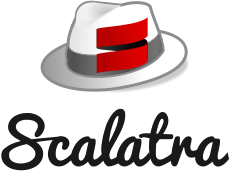Scalatra
 | |
| Original author(s) | Scalatra contributors |
|---|---|
| Initial release | April 11, 2009 |
| Stable release | 2.4.0
/ December 20, 2015[1] |
| Repository | |
| Operating system | Cross-platform |
| Available in | Scala |
| Type | Web application framework |
| License | BSD |
| Website | scalatra |
Scalatra is a free and open source web application framework written in Scala.[2] It is a port of the Sinatra framework written in Ruby. Scalatra is an alternative to the Lift, Play!, and Unfiltered frameworks.
Scalatra is an example of a microframework, a web software development framework which attempts to be as minimal as possible.
A full Scalatra application can be written in very few lines of code:
package org.example.app
import org.scalatra._
class MyScalatraFilter extends ScalatraFilter {
get("/hello/:name") {
<h1>Hello, {params("name")}</h1>
}
}
From this tiny domain-specific language, Scalatra can be expanded into a minimal but full-featured model-view-controller web framework. For example, additional libraries can be attached in order to provide templating, object-relational mapping, and unit testing or behaviour driven development support.
Software built with Scalatra
- LinkedIn used Scalatra to power its now-defunct[3] Signal API.[4]
- Parts of The Guardian's API services are built in Scalatra.[5]
- http://gov.uk has built its API systems using Scalatra.[6]
References
- ^ http://www.scalatra.org/2015/12/20/scalatra-2-4-released.html
- ^ Synodinos, Dionysios G. (2010-10-07). "Scalatra: A Sinatra-like Web Framework for Scala". InfoQ.
- ^ "LinkedIn Signal - No Longer Supported". 2013-08-22.
- ^ Synodinos, Dionysios G. (2010-10-11). "LinkedIn Signal: A Case Study for Scala, JRuby and Voldemort". InfoQ.
- ^ "Github Scalatra OpenID Consumer code".
- ^ "With GOV.UK, British government redefines the online government platform". O'Reilly. 2012-01-31. Retrieved 13 March 2012.
